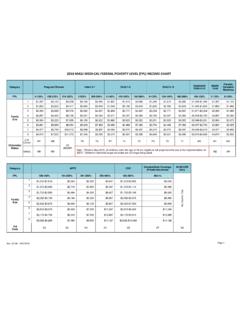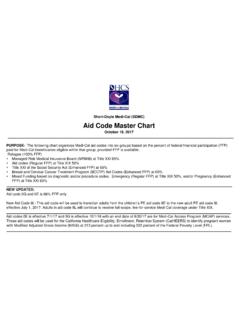Transcription of Getting and Keeping Health Coverage for Low-Income ...
1 Getting and Keeping Health Coverage for Low-Income Californians: A Guide for Advocates March 2016. Jen Flory, Elizabeth Landsberg, Shirley Sanematsu, and Mona Tawatao Made Possible With Support From Acknowledgments Who We Are Western Center on Law & poverty fights for justice for Low-Income Californians by improving and transforming the public policy systems that touch their lives. We focus on Health care, affordable housing, public benefits, racial equity and access to justice issues. Western Center uses a multi-pronged approach to improve the lives of Californians living in poverty . Our staff brings impact litigation in state and federal courts, educates policymakers and stakeholders, sponsors legislation, conducts budget advocacy, promotes better programs and policies at administrative agencies, and provides consultation and trainings to the State's legal services programs and community-based organizations.
2 For more information about us, please see our website at Acknowledgments This guide was funded by a grant from the California Health Care Foundation. We are grateful to the foundation and Catherine Teare, our grant manager, for their unwavering support and flexibility throughout the process. We express our deep appreciation for the team at Manatt Health , led by Alice Lam and including Melinda Dutton, Alexander Dworkowitz, and Rashi Kesarwani. Their Health law expertise proved invaluable in reorganizing portions of the guide and reviewing drafts for consistency and technical accuracy. We were also fortunate to have a great team of advocate reviewers who provided in-depth knowledge on specific subject areas: Kim Lewis, Cori Racela, and Abbi Coursolle of the National Health Law Program; Dan Brzovic of Disability Rights California; Julie Silas of Consumers Union; Donald Nollar of Maternal and Child Health Access; Lucy Quacinella of Multiforum Advocacy Solutions; Assmaa Elayyat of the California Welfare Directors Association; and Sonal Ambegaokar.
3 Special thanks as well to Western Center staff Suzie Convery, Aurora Colindres, Jason Rivera, Amanda Smith, and Paul Tepper for their assistance throughout the project. We are also grateful to Amalea Romero and Marina Anthony who assisted in drafting and cite checking portions of the guide while they were law clerks with us. ii Getting and Keeping Health Coverage for Low-Income Californians: A Guide for Advocates We also thank Jessica Fry, our graphic designer for this project who patiently worked with us to develop the look and feel of the guide. And finally, our humble recognition of Katie Murphy and Kim Lewis who wrote the original 2005 Med-Cal Eligibility Guide that was the backbone for this guide. Some of their original words are still here.
4 Jen Flory Elizabeth Landsberg Shirley Sanematsu Mona Tawatao iii Table of Contents Overview of this Guide 1. Introduction to Part I: Eligibility Criteria At-A-Glance 5. A. Citizenship and Immigration Status 6. 1. Mixed Status Families 7. B. Residency 7. C. Household and Income Requirements 7. 1. Income Threshold and Income Counting 7. 2. Household Determination 9. D. Age 9. E. Incarceration 10. F. Other Health Coverage 10. G. Tax Filing Status 11. H. Assets or Resources 11. I. Insurance Affordability Programs at a Glance 13. Chapter 1: Overarching Eligibility Issues for Medi-Cal 15. A. Citizenship and Immigration Status 16. 1. Immigrants Eligible for Full-scope Medi-Cal 16. a. Qualified Immigrants 16. b. Lawfully Present and PRUCOL 20.
5 2. Restricted Scope Medi-Cal 21. a. Services Covered Under Restricted Medi-Cal 22. b. Additional Programs Available Regardless of Immigration 23. Status B. Incarceration/Institutionalization 24. C. Residency 26. Getting and Keeping Health Coverage for Low-Income Californians: A Guide for Advocates D. Other Health Coverage 27. E. Tax Filing Status 28. F. The Medi-Cal Hierarchy 28. Chapter 2. MAGI Medi-Cal Programs 30. A. Constructing Households 31. 1. Tax Filer Rules 32. 2. Non-Filer Rules 33. 3. Counting Households with a Pregnant Woman 34. B. Counting Income 34. C. MAGI Medi-Cal Programs 36. 1. Expansion Adults 36. 2. Parents and Caretaker Relatives 41. 3. Pregnant Women 44. a. MAGI Medi-Cal Programs for Pregnant Women 44. b. Medi-Cal Access Program (MCAP) for Pregnant Women and 49.
6 Newborns up to Age 2. 4. Children: MAGI Medi-Cal, the Targeted Low-Income Children's Program, 54. and MCAP Infants and Babies a. Infants: 0 to 1 year old 57. b. Children: Ages 1 to 6 58. c. Children: Ages 6 to 19 59. Chapter 3. Non-MAGI Medi-Cal 62. A. Non-MAGI Household and Income 64. B. Full-Scope Non-MAGI Medi-Cal for Seniors and Individuals with Disabilities 65. 1. Categorically Linked Medi-Cal Based on Disability 65. a. Automatic Medi-Cal for Individuals Receiving Supplemental Security 65. Income (SSI-b. linked Medi-Cal). b. SSI 1619(b) Medi-Cal for Individuals who Lost SSI Because of Earnings 66. from Work 2. Severely-Impaired Working Individual (SIWI) Program 68. 3. Pickle Program 69. 4. Disabled Adult Child (DAC) Medi-Cal 71.
7 5. Disabled Widow/Widower Programs 74. Getting and Keeping Health Coverage for Low-Income Californians: A Guide for Advocates v Getting and Keeping Health Coverage for Low-Income Californians: A Guide for Advocates 6. Aged and Disabled Federal poverty Level (A&D FPL) and Blind Federal 75. poverty Level (Blind FPL) Programs a. Special Rules for A&D FPL and Blind FPL Programs 82. 7. 250% Working Disabled Program (250% WDP) 83. 8. Aged, Blind and Disabled Medically Need (ABD-MN): Free and Share of 90. Cost C. Full-Scope Non-MAGI Medi-Cal for Children and Families 98. 1. Automatic Eligibility Due to Receipt of Government Benefits 99. 2. Children in Foster Care 100. 3. Former Foster Youth Under Age 18 and Not Living with their Parents 102.
8 4. Former Foster Youth 18 and Older 102. 5. Transitional Medi-Cal (TMC) 104. 6. Continuous Eligibility for Children 106. 7. Deemed Eligibility for Newborns 107. 8. Aid for Families with Dependent Children Medically Needy 108. 9. Medically Indigent 110. D. Limited Scope Medi-Cal Programs for Children 111. 1. Minor Consent 111. 2. Income Disregard Program for Pregnant Girls under Age 21 112. 3. The Child Health and Disability Prevention (CHDP) Program 113. E. Medi-Cal Special Treatment Programs 114. 1. Breast and Cervical Cancer Treatment Programs 114. 2. Tuberculosis Program 116. 3. Kidney Dialysis and Parenteral Hyperalimentation and Related Services 117. F. Medicare Savings Programs (MSPs) 119. 1. Qualified Medicare Beneficiary (QMB or Quimby ) Program 121.
9 2. Specified Low-Income Medicare Beneficiaries (SLMB) Program 122. 3. Qualified Individual (QI) Program 123. 4. Qualified Disabled and Working Individual (QDWI) Program 124. G. Refugee Medical Assistance 125. Chapter 4. Covered California 128. A. Qualified Health Plans 131. 1. Essential Health Benefits 131. 2. Standard Benefit Design 132. Getting and Keeping Health Coverage for Low-Income Californians: A Guide for Advocates vi Getting and Keeping Health Coverage for Low-Income Californians: A Guide for Advocates B. Eligibility to Purchase Coverage Through Covered California 135. 1. Citizenship and Immigration Status 135. 2. Incarceration 138. 3. Residency 139. 4. Age 140. C. Eligibility for Financial Assistance 140. 1. Lack of Minimum Essential Coverage 141.
10 A. Months of Partial Coverage 143. b. Eligible But Not Enrolled 144. c. Special Rules Regarding Employer Coverage 145. i. Affordability and Value of Other Coverage 145. ii. Family Glitch 146. iii. The Enrolled Employee Exception 146. iv. COBRA 147. 2. Income Threshold for Financial Assistance 147. a. Exceptions to the Lower Limit of Eligibility: Individuals Below 148. 100%FPL. b. Income Counting: Modified Adjusted Gross Income (MAGI) 148. Methodology i. Household Size and Members 150. ii. Children 150. iii. Special Consideration for Pregnancy and Newborns 151. iv. Qualifying Relative Dependents 151. v. Spouses 152. vi. Family Members Who are Not Lawfully Present 153. 3. Assets 153. 4. Tax Filing Status 153. a. Must File Taxes for the Year that Premium Tax Credits are 153.



